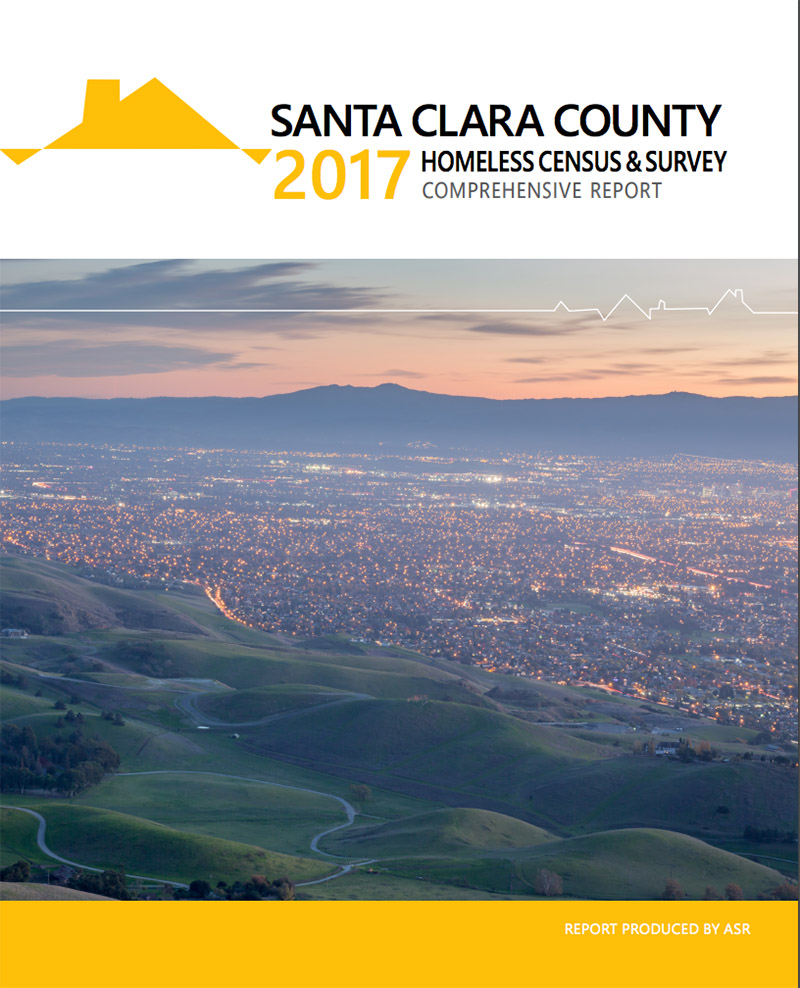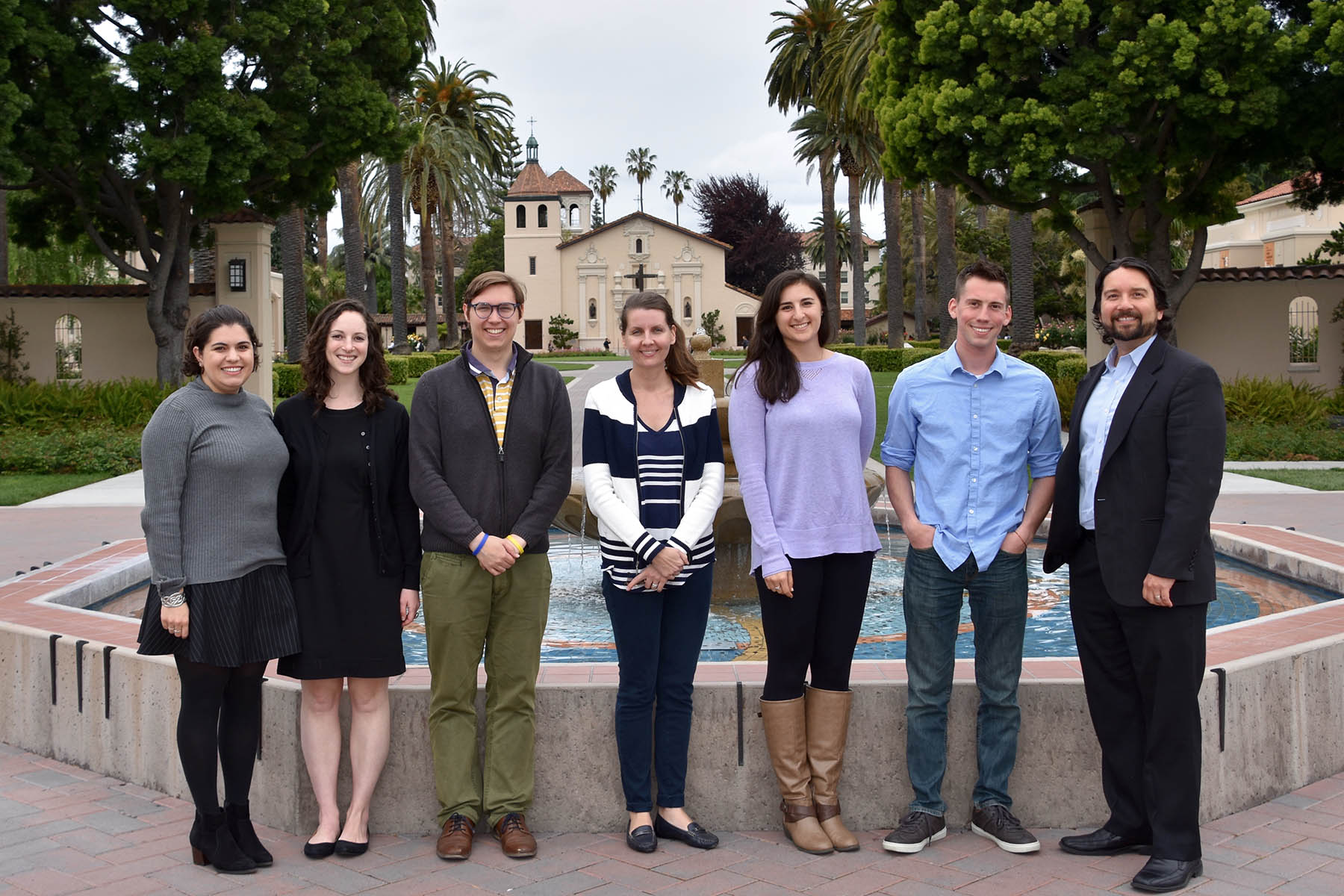by SCU International Human Rights Clinic Student Anna Saber
Throughout the 2016-17 academic year, students in the International Human Rights Clinic have been working on a human rights report on homelessness with a gender lens in the County of Santa Clara. For a review of what we did in Fall 2016, check out our previous blog post. This blog post summarizes the work we did in Spring 2017.
Veteran clinic student attorneys Kyle Heitmann, Courtney Kimmey, Anna Saber, and Susan Shapiro were joined by new students Elina Ahtela, Amisha DeYoung Dominguez, Melissa Fox, and Roman Friedrich. Most of our work in Spring 2017 involved designing and implementing two key data collection mechanisms: a survey instrument and focus groups. Kyle and Anna worked closely with Clinic Director Francisco Rivera, Professor David Sloss, and several Santa Clara County homeless shelters and programs to finalize the survey instrument and facilitate the distribution of the surveys to relevant service providers. Meanwhile, Susan led our focus group initiative, working with the Santa Clara County Office of Woman’s Policy to develop focus group procedures in a manner that focused on the sensitivity of the subject matter and the vulnerability of women who have survived the trauma of living homeless.
Survey: Working with Raw Data
The Clinic developed and distributed surveys for our data collection efforts, with the help of the following service providers: Abode Services, Bill Wilson Center, Home First Services, Housing Authority of County of Santa Clara, Life Moves, New Directions, Next Door Solutions, SCC Office of Supportive Housing, St. Joseph’s Family Center, and YWCA. Together, we defined our survey population as follows: adult women currently living in Santa Clara County who were previously homeless and who (1) are now living in permanent supportive housing (PSH), or (2) since January 1, 2015, have been placed in housing through a rapid rehousing program (RRH), or (3) since January 1, 2015, have moved from a transitional housing program (TH) into stable, independent housing, and are not included in the first two categories. We distributed surveys to a total of 657 women and received responses from 297 women. We are currently in the process of analyzing that data and comparing it with other county-wide studies on homelessness, such as the 2017 Santa Clara County Homeless Census and Survey.

Because maintaining the confidentiality of the women who responded to the survey was of the utmost importance, the Clinic did not have any direct contact with survey participants. Rather, the shelters and service providers could either mail the blank surveys to the women or facilitate in-person survey responses. Having a response rate of close to 50% was very inspiring for the clinic members, who were elated that these women took the time to detail the story of their homelessness journey. Clinic students then began the task of inputting the raw survey data. The survey asked 52 questions, some with multiple parts, and each question had to be carefully inputted to ensure the utmost accuracy of data. Each clinic student was responsible for at least ten hours of survey data entry, but many did more! Once all the raw data was entered, Professor Sloss used the data to run statistical calculations. The data showed results consistent with what we learned from the interviews with the service providers and align with our initial research, which was rewarding for the clinic students. It certainly was promising that our results solidified what we had learned thus far.
Focus Groups: Real Women, Real Stories
The focus group aspect of the project began back at the beginning of the academic year in September 2015 when the Clinic and the Office of Women’s Policy first began endeavoring on this project. We wanted to interview presently homeless women, to receive first-hand knowledge from those who have experienced homelessness and to give these women a chance to tell their stories. But we also had to meet the University’s Internal Review Board’s strict approval requirements for research using human subjects, which meant that we had to minimize any chance of re-traumatization of these women. Clinic students Susan Shapiro and Melissa Fox worked tirelessly with the Office of Women’s Policy and the five domestic violence-focused service providers in Santa Clara County to learn how best to frame the questions and the appropriate way to interact with these women to minimize the trauma. After endless hours, the Clinic finally received IRB approval for the focus groups!
Not only was it important to ask the question in a non-traumatic fashion, it was crucial that the clinic students facilitating the focus groups be sensitive to the risks associated with human-subject research. Before a clinic student could facilitate a focus group, the student participated in a 2-hour online course designed to explain the risks associated with such research, best-practices procedures for conducting the research, and institutional safeguards – such as IRB approval – designed to ensure protection at all stages of the research. Further, each student focused on using the term “survivor,” rather than “victim” when referring to those who had experienced intra-partner violence. During the focus groups session, we began by recognizing that talking about being homeless was difficult and reminding the women that each of them were in control of the information shared; if the story was too traumatizing to tell, they could choose not to tell it. This cognizance meant that the focus group facilitators were attuned to potentially trauma triggers and could shape the procedures accordingly. For example, during the first focus group, the clinic students realized that some of the women would recoil whenever spoken to by a male facilitator. Because of the horrific violence these women had experienced, some of the women were simply not comfortable. Thus, the female clinic students took the lead on facilitating the focus group sessions and the male clinic students assumed the role of note taker to ensure that the women would be more comfortable.
Overall, the clinic conducted five focus groups and each of the sessions were both incomprehensibly saddening and inspiring. The focus group sessions were the first time in almost a year of working on this project that the students got to interact with the very women who are the focus of the study. Through this first-hand interaction, clinic students could hear stories and understand what being homeless as a woman means for the women experiencing it. From the focus groups, we learned that women who are homeless are propositioned for sexual favors, often have the added stressor of having children with them, have less resources than homeless men, have the additional challenge of finding feminine hygiene products, and have unique safety risks associated with using the bathroom. Women who are survivors of intra-partner violence often have been dependent on their abuser for so long that being self-sufficient is challenging. Clinic student Melissa Fox learned in her focus group with homeless women of Asian descent of the role culture plays. For women of Asian descent, many expressed that the male is the provider in the household. After years of being financially dependent, when these women would finally leave the abuser, they were not able to be self-sufficient.
Clinic student Anna Saber facilitated a focus group session with eight survivors of domestic violence. The first response to the question “how is being homeless as a female different from being a homeless male?” was “men don’t have kids with them.” The second response was “men don’t get asked to prostitute themselves.” Both responses were had a profound impact on clinic student Anna, who reflected upon the experience as follows:
“It really is devastating when a young woman with young children concludes that being on the street is safer than being in a shelter because if the shelter is co-ed these mothers don’t know if the shelter is also housing rapists and molesters. The streets are not a place for a child to grow up; the fact that the streets are sometimes the safest place for homeless mothers and children is terrible.”
Anna also reeled when the women shared stories of being propositioned for sex:
“One of the women stated that anytime she asked for a couple of bucks or some help, the response was always ‘I’ll help you if you do [X].’ These women are already vulnerable, have already been survivors of abuse, and now they are being taken advantage of constantly. Hearing about the humiliation suffered by these women when continually being propositioned was heartbreaking for me – I heard these women tell these horrific stories and I wanted to break down crying – how can people take advantage of the vulnerability and desperation of homeless women simply to satisfy their own sexual desires?”
Not only were these women propositioned, but eventually some of the women gave in. One of the women, Sarah (note, not real name as the entire focus group was conducted with the utmost confidentially), described that while she was at first disgusted by the thought of sleeping with a man for money or help, she soon realized that if she could make money each time, she soon could afford to buy a car. As Sarah described, a car is a haven and home for homeless women. It’s a safe space to sleep and protection from the elements. Sarah described prostituting herself as hitting rock bottom, but recognized the necessity of doing so to survive. Sarah rationalized her decision out of pure necessity and stated that in another life she probably would have had dinner with the guy, as a way of convincing herself that she was being “selective.” “There are women who had a job, had a home, and who are now prostituting out of necessity, all because these women made the decision to leave an abusive partner. There are certainly gaps in the system if the only way these women can survive is by having sex for money,” remarked clinic student Anna.

The focus group sessions were truly eye-opening and inspiring for many of the clinic members. The students were reminded of the goal of the report and were re-invigorated with the reminder of the report’s importance. All year we have been researching the human right to housing, examining existing domestic law addressing homelessness and the right to housing, interviewing service providers, meeting with members of the Office of Women’s Policy, and analyzing survey data. This is the first time that we are going straight to the source and hearing the stories from the homeless women themselves. “There was no sugar-coating: these women were blunt and not afraid to talk about the reality of being homeless, the lack of space at shelters, and the services they thought were most needed. It was inspiring to hear these women tell their stories and ignited passion in my heart for this project,” remarked Anna.
At the close of the Spring 2017 semester, the Clinic finished all of its data collecting and was in the process of analyzing it. Over the next few weeks we will be working hard with the County of Santa Clara to have a report ready for publication. Stay tuned for more updates.